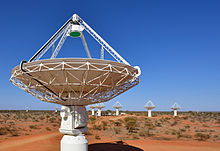Australian Square Kilometre Array Pathfinder

Antennas of the ASKAP telescope at the Murchison Radio-astronomy Observatory in Western Australia
|
|
| Organisation |
Commonwealth Scientific and Industrial Research Organisation |
|---|---|
| Location(s) |
Murchison Radio-astronomy Observatory |
| Coordinates | 26°41′46″S 116°38′13″E / 26.696°S 116.637°ECoordinates: 26°41′46″S 116°38′13″E / 26.696°S 116.637°E |
| Telescope style | |
| Website | www |
|
|
|
|
[]
|
|
|
|
The Australian Square Kilometre Array Pathfinder (ASKAP) is a radio telescope array located at Murchison Radio-astronomy Observatory (MRO) in the Australian Mid West. ASKAP consists of 36 identical parabolic antennas, each 12 metres in diameter, working together as a single instrument with a total collecting area of approximately 4,000 square metres.
It is operated by the governmental research agency CSIRO and forms part of the Australia Telescope National Facility.
ASKAP's combination of fast survey speed and high sensitivity will allow activities such as researching the creation and early evolution of the Universe, analysing cosmic magnetism, testing predictions of the general theory of relativity, mapping black holes, and exploring the origins of galaxies.
ASKAP is also a technology demonstrator for the international Square Kilometre Array (SKA), a planned radio telescope that is planned to be the world's largest and most sensitive. The ASKAP's home, the MRO, has also been selected as one of the SKA's two central location.
Construction on ASKAP began in late 2009 and was completed in October 2012, at which point it became world's fastest radio telescope.
Development and construction of ASKAP was led by CSIRO Astronomy and Space Science (CASS), in collaboration with scientists and engineers in The Netherlands, Canada and the USA, as well as colleagues from Australian universities and industry partners in China.
The Wajarri Yamatji people are the traditional owners of the land on which the observatory lies.
...
Wikipedia
